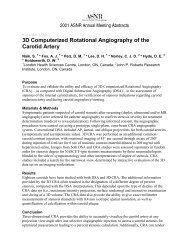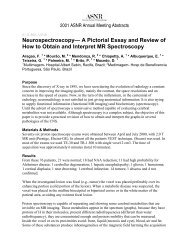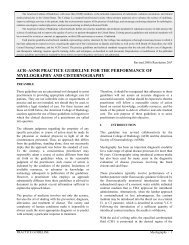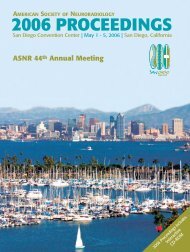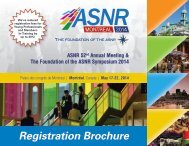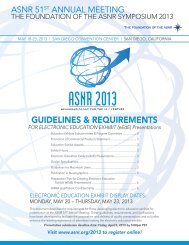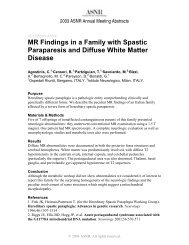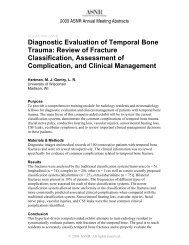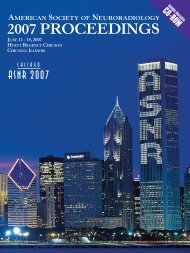<strong>the</strong>rapy (<strong>for</strong> outpatient procedures), an unplanned increasein <strong>the</strong> level <strong>of</strong> care, prolonged hospitalization, permanentadverse sequelae, or death. Minor complications result inno sequelae, but may require nominal <strong>the</strong>rapy or a shorthospital stay <strong>for</strong> observation (generally overnight; seeAppendix A). The complication rates and thresholdsdescribed herein refer to major complications.Routine periodic review <strong>of</strong> all cases having less thanperfect outcomes is strongly encouraged. Seriouscomplications <strong>of</strong> vertebral augmentation are infrequent. Areview is <strong>the</strong>re<strong>for</strong>e recommended <strong>for</strong> all instances <strong>of</strong>death, infection, or symptomatic pulmonary embolus.Table 1: Vertebral Augmentation Success Rates [51-58]Success RatesWhen vertebral augmentation is per<strong>for</strong>med <strong>for</strong>osteoporosis, procedure outcomes can be defined using<strong>the</strong> criteria by Hodler et al [50] with patients categorizedas worse, same, better, or pain/disability gone. For <strong>the</strong>purpose <strong>of</strong> this document pain/disability gone is definedas improved. There<strong>for</strong>e patients should be categorized asei<strong>the</strong>r improved, <strong>the</strong> same, or worse. This categorizationshould be determined with <strong>the</strong> use <strong>of</strong> a validatedmeasurement tool.When vertebral augmentation is per<strong>for</strong>med <strong>for</strong> neoplasticinvolvement, success is defined as achievement <strong>of</strong>significant pain relief and/or improved mobility asmeasured by validated measurement tools.Published Success Rates Threshold <strong>for</strong> ReviewNeoplastic, all causes 70% to 92% 10%Permanent neurological deficit (within 30 days <strong>of</strong><strong>the</strong> procedure or requiring surgery)OsteoporosisNeoplasm1%>5%Fracture <strong>of</strong> rib, sternum or vertebra 1% >2%Allergic or idiosyncratic reaction 1%Infection 0%Symptomatic pulmonary material embolus 0%Significant hemorrhage or vascular injury 0%Symptomatic hemothorax or pneumothorax 0%Death 0%The overall procedure threshold <strong>for</strong> all complications resulting from vertebral augmentation per<strong>for</strong>med <strong>for</strong> osteoporosis is2%, and when per<strong>for</strong>med <strong>for</strong> neoplastic indications it is 10%.8 / Vertebral Augmentation PRACTICE GUIDELINE
IX.RADIATION SAFETY IN IMAGINGRadiologists, medical physicists, radiologic technologists,and all supervising physicians have a responsibility tominimize radiation dose to individual patients, to staff,and to society as a whole, while maintaining <strong>the</strong> necessarydiagnostic image quality. This concept is known as “aslow as reasonably achievable (ALARA).”Facilities, in consultation with <strong>the</strong> medical physicist,should have in place and should adhere to policies andprocedures, in accordance with ALARA, to varyexamination protocols to take into account patient bodyhabitus, such as height and/or weight, body mass index orlateral width. The dose reduction devices that areavailable on imaging equipment should be active; if not;manual techniques should be used to moderate <strong>the</strong>exposure while maintaining <strong>the</strong> necessary diagnosticimage quality. Periodically, radiation exposures should bemeasured and patient radiation doses estimated by amedical physicist in accordance with <strong>the</strong> appropriate ACRTechnical Standard. (ACR Resolution 17, adopted in2006 – revised in 2009, Resolution 11.)X. QUALITY CONTROL ANDIMPROVEMENT, SAFETY, INFECTIONCONTROL, AND PATIENT EDUCATIONPolicies and procedures related to quality, patienteducation, infection control, and safety should bedeveloped and implemented in accordance with <strong>the</strong> ACRPolicy on Quality Control and Improvement, Safety,Infection Control, and Patient Education appearing under<strong>the</strong> heading Position Statement on QC & Improvement,Safety, Infection Control, and Patient Education on <strong>the</strong>ACR web site (http://www.acr.org/<strong>guideline</strong>s).ACKNOWLEDGEMENTSThis <strong>guideline</strong> was revised according to <strong>the</strong> processdescribed under <strong>the</strong> heading The Process <strong>for</strong> DevelopingACR Practice Guidelines and Technical Standards on <strong>the</strong>ACR web site (http://www.acr.org/<strong>guideline</strong>s) by <strong>the</strong>Guidelines and Standards Committees <strong>of</strong> <strong>the</strong> Commissionon Neuroradiology and <strong>the</strong> Commission on Interventionaland Cardiovascular Radiology in collaboration with <strong>the</strong>ASNR, <strong>the</strong> ASSR, <strong>the</strong> SIR, and <strong>the</strong> SNIS.Collaborative Committee – members represent <strong>the</strong>irsocieties in <strong>the</strong> initial and final revision <strong>of</strong> this <strong>guideline</strong>.ACRJoshua A. Hirsch, MD, FACR, ChairJohn E. Jordan, MDPhilip M. Meyers, MDJohn D. Statler, MDASNRDavid F. Kallmes, MDJerry G. Jarvik, MDASSRDmitry Niman, MDDan L. Nguyen, MDR. Sean Pakbaz, MDKent B. Remley, MDMichael I. Rothman, MDSIRJohn D. Barr, MDJ. Kevin McGraw, MDSNISAllan L. Brook, MDMary (Lee) Jensen, MDAlbert J. Yoo, MDGuidelines and Standards Committee – Interventional –ACR Committee responsible <strong>for</strong> sponsoring <strong>the</strong> draftthrough <strong>the</strong> processDonald L. Miller, MD, Chair, FACRAradhana M. Venkatesan, MD, Vice-ChairStephen Balter, PhD, FACRRobert G. Dixon, MDLawrence T. Dauer, PhDJoshua A. Hirsch, MD, FACRSanjoy Kundu, MDPhilip M. Meyers, MDJohn D. Statler, MDMichael S. Stecker, MDTimothy L. Swan, MDRaymond H. Thornton, MDAnne C. Roberts, MD, FACR, Chair, CommissionGuidelines and Standards Committee – Neuroradiology –ACR Committee responsible <strong>for</strong> sponsoring <strong>the</strong> draftthrough <strong>the</strong> processJacqueline A. Bello, MD, FACR, ChairJohn E. Jordan, MD, Vice-ChairMark H. Depper, MDAllan J. Fox, MD, FACRSteven W. Hetts, MDEllen G. Hoeffner, MDThierry A.G.M. Huisman, MDStephen A. Kieffer, MD, FACRSrinivasan Mukundan, MD, PhDEric M. Spickler, MD, FACRAshok Srinivasan, MDKurt E. Tech, MD, MMM, FACRMax Wintermark, MDCarolyn C. Meltzer, MD, FACR, Chair, CommissionPRACTICE GUIDELINE Vertebral Augmentation / 9



